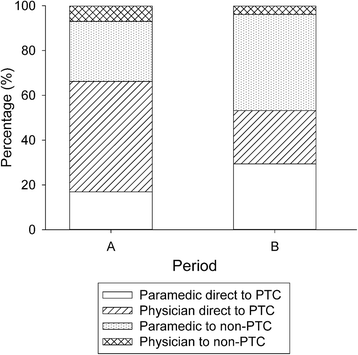Physician staffed helicopter emergency medical service case identification - a before and after study in children
- PMID: 27405354
- PMCID: PMC4941013
- DOI: 10.1186/s13049-016-0284-6
Physician staffed helicopter emergency medical service case identification - a before and after study in children
Abstract
Background: Severely injured children may have better outcomes when transported directly to a Paediatric Trauma Centre (PTC). A case identification system using the crew of a physician staffed helicopter emergency medical service (P-HEMS) that identified severely injured children for P-HEMS dispatch was previously associated with high rates of direct transfer. It was theorised that discontinuation of this system may have resulted in deterioration of system performance.
Methods: Severe paediatric trauma cases were identified from a state based trauma registry over two time periods. In Period A the P-HEMS case identification system operated in parallel with a paramedic dispatcher (Rapid Launch Trauma Co-ordinator-RLTC) operating from a central control room (n = 71). In Period B the paramedic dispatcher operated in isolation (n = 126). Case identification and direct transfer rates were compared as was time to arrival at the PTC.
Results: After cessation of the P-HEMS system the rate of case identification fell from 62 to 31 % (P < 0.001), identification of fatal cases fell from 100 to 47 % (P < 0.001), the rate of direct transfer to a PTC fell from 66 to 53 % (P = 0.076) and the time to arrival in a PTC increased from a median 69 (interquartile range 52 - 104) mins to 97 (interquartile range 56 - 305) mins (P = 0.003). When analysing the rate of direct transfer to a PTC as a function of team composition, after adjusting for age and injury severity scores, there was no change in the rate between the physician and paramedic groups across the two time periods (relative risk 0.92, 95 % CI: 0.44 to 1.41).
Discussion: The parallel identification system improves case identification rates and decreases time to arrival at the PTC, whilst requiring RLTC authorisation preserves the safety and efficiency benefits of centralised dispatch. The model could be extended to adult patients with similar benefits.
Conclusions: A case identification system relying solely on RLTC paramedics resulted in a significantly lower case identification rate and increased prehospital time with a non-significant fall in direct transfer rate to the PTC. The elimination of the P-HEMS input from the tasking system resulted in worse performance indicators and has the potential for poorer outcomes.
Keywords: Dispatch; HEMS; Paediatric; Physician; Prehospital; Trauma.
Figures
References
MeSH terms
LinkOut - more resources
Full Text Sources
Other Literature Sources
Medical


